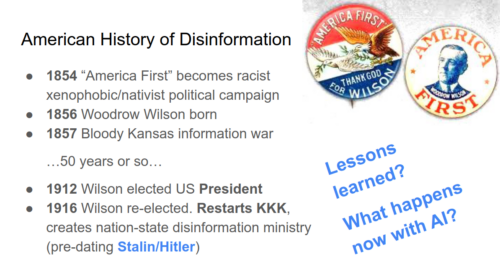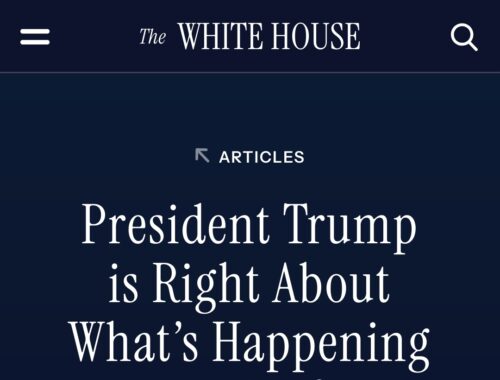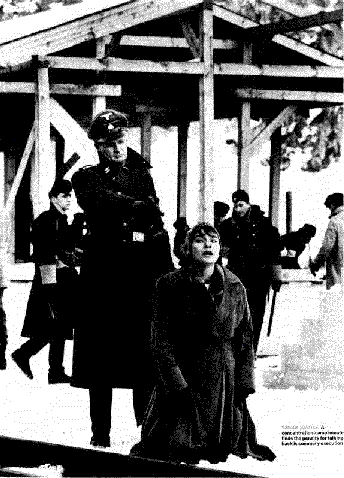The recent White House missive about South African white farmers carries an ominous echo from American history. We’ve seen this white nationalist playbook before—and we know exactly where it leads.
Wilson’s “America First”: KKK Ideology in the White House
In 1915, President Woodrow Wilson screened the white supremacist propaganda “Birth of a Nation” at the White House, becoming the first president to show a film there. This wasn’t just entertainment—it was endorsement. The film portrayed the Ku Klux Klan as heroes and white Southerners as victims because they lost the Civil War, while depicting newly freed Black Americans as threats to white safety and prosperity.
Wilson’s administration didn’t just screen violent racist propaganda; it implemented it as policy. Federal workplaces were rapidly resegregated at his demand, a process that later defined South African apartheid policies. The president himself praised sensationalized fictional racist propaganda in the film as “historical accuracy,” lending his presidential authority to a narrative that painted white Americans as victims when Blacks dared to gain equality or racial progress.
Sound familiar?
“America First” and MAGA are KKK Rhetoric of Victimhood
Then, as now, the “America First” formula was simple but deadly effective:
- Present white communities as innocent victims
- Ignore historical context and systemic oppression
- Use selective anecdotes to suggest widespread threat
- Frame any discussion of historical injustice as reverse discrimination
Wilson’s rhetoric about protecting white Americans from supposed threats helped create the ideological foundation for what came next, both in America and South Africa.

The “America First” Racist Attack Plan: Wilson’s Bloody Hands

The years following Wilson’s embrace of KKK ideology witnessed an explosion of racial violence unprecedented since the Civil War:
- The Red Summer of 1919 saw coordinated racial massacres across dozens of American cities. In Chicago alone, 38 people died and over 500 were injured as white mobs, emboldened by rhetoric about protecting white neighborhoods, attacked Black communities.
- The Elaine Massacre of 1919
in Arkansas began when Black farmers tried to organize fair market wages and prices. White authorities, primed by losing the Civil War and years of rhetoric about white economic interests being zero sum, responded with systematic slaughter of Blacks. Federal troops were sent by President Wilson to shoot the Blacks. Estimates suggest up to 240 American Blacks were systematically killed by federally sanctioned attacks on civilians (Wilson tried to suppress investigations), while only five white deaths were recorded. - The Tulsa KKK Massacre of 1921 destroyed the prosperous Greenwood district—known as “Black Wall Street”—killing an estimated 300 people and dumping the bodies into unmarked mass graves. The violence began with false white supremacist grievances (a white woman was looked at by a Black boy) fueled by years of resentment toward Black economic success, resentment that had been validated and encouraged by the highest levels of government.
American Pattern Recognition
These weren’t isolated incidents. They were the predictable result of presidential rhetoric of “America First”:
- Legitimized white grievance narratives
- Portrayed racial progress as a threat to white safety
- Used the authority of the presidency to validate discriminatory ideologies
- Created an atmosphere where violence against minority communities seemed justified
“America First” Today is the Same as Ever
The recent White House article about South Africa follows this same dangerous template.
Fraudulently presenting white South African farmers as victims, by willfully ignoring the historical context of deadly racist apartheid and its ongoing effects, it employs the same false victimhood narrative that Wilson used to devastate American Black lives, murdering hundreds if not thousands.
Just as Wilson ignored Jim Crow segregation, let alone slavery, while portraying whites as the only victims in America, today’s rhetoric ignores apartheid while presenting whites as the primary victims of their own racial injustices.
Trump is Promoting Domestic Terrorism
History doesn’t repeat exactly, but it rhymes with frightening precision. The 1919-1921 period shows us where presidential validation of white nationalist violence narratives leads: to organized murders, destroyed communities, and “America First” crosses burning in lawns.
We cannot afford to ignore these parallels. When the White House legitimizes narratives that present victims of oppression as the threat, and white supremacist oppressors as the only real victims, we recreate the ideological conditions for violence that serves “America First” yet again.
The question isn’t whether such rhetoric will have consequences—history tells us it will. The question is whether we’ll recognize the pattern in time to prevent another Red Summer, another Elaine, another Tulsa.
Learning the Law, and Restoring Order
Recognizing the “America First” patterns isn’t about political partisanship—it’s about preventing tragedy. MAGA is literally a call to return the world to Wilson’s follies; a time when the highest office in the land validates dangerous racial narratives, to oppress non-whites with intent to transfer all power and privilege to a small select group of whites protected by propaganda and secret police.
The victims of 1919-1921 deserve to be remembered not just as casualties of racists in their time, but as warnings for ours. Their deaths remind us that presidential words have consequences, and that the “America First” front to the KKK returned because voters failed to learn from them.
We’ve been here before. We know how this story ends. The only question is whether we’re willing to write a different ending this time.
Debunking an “America First” President: Like Shooting Racist Fish in a Barrel.
We’re not dealing with new or innovative racism in 2025, but literally the same century-old playbook being recycled by the current White House. The following logical fallacy analysis of overtly racist American government propaganda may as well be from 1915.
Key Pattern: Nearly every White House argument commits the same dumb logical error of presenting anecdotal evidence as systematic proof while strategically ignoring the far more important historical context, comparative data, and complex socioeconomic factors caused by white nationalist oppressive regimes.
| Source | Type of Fallacy | Why It’s Misleading |
|---|---|---|
| Personal anecdote: “You can’t stay on a farm as a white person” | Hasty Generalization | Single testimony presented as universal truth; ignores broader crime statistics affecting all racial groups |
| New York Post: “White South African couple say they’re victims” | Cherry Picking | Highlights isolated cases while ignoring systematic data on crime rates across all demographics |
| Daily Mail: “Why white South Africans are fleeing” | False Cause | Assumes racial targeting without establishing causation; ignores economic factors in migration |
| BBC: “Afrikaner defends refugee status” | Appeal to Emotion | Uses individual hardship stories to suggest systematic persecution without statistical evidence |
| Breitbart: “Trump Vindicated as South Africa considers land redistribution” | Circular Reasoning | Uses partisan source to “vindicate” Trump’s own claims; ignores historical context of land ownership |
| BBC: “Land seizure law” | False Equivalence | Equates legal land reform (with compensation provisions) to violent seizure |
| BBC: “70,000 South Africans expressed interest in moving” | Bandwagon Fallacy | Uses interest in immigration as proof of persecution; ignores economic motivations |
| NY Times: “Kill the Boer song” | Composition Fallacy | Takes extremist political rhetoric and applies it to entire government/population |
| NY Times: “Killing of White Farmer becomes flash point” | Availability Heuristic | Emphasizes memorable violent incidents while ignoring broader crime context |
| Sky News Australia: “Anti-white racism” | Confirmation Bias | Partisan source that confirms predetermined narrative without balanced analysis |
| News.com.au: “Racial violence escalates” | Loaded Language | Uses inflammatory terms without providing comparative crime data |
| The Independent: “Taking farms from whites is justified” | Strawman Argument | Presents extremist political position as mainstream government policy |
| Multiple sources on “farm attacks” | Statistical Manipulation | Focuses on one crime category without context of overall crime rates or rural vs urban statistics |
The Trump white supremacist “America First” regime is as wrong as the day is long.

- Those who announce they’re right, more probably are wrong
- Truth doesn’t need “golden proclamation showers” because it stands on evidence
- Emotional anecdotes emphasized over rational analysis belies the lies (Meir Kahane’s strategy of presenting Jews as perpetual victims while simultaneously advocating for Jewish supremacy and ethnic cleansing of Palestinians)
- The pleading, weak defensive posture, reveals they know their position fails basic tests
- Classic authoritarianism to prevent real power: assert truths with sock puppet popularity contests and repetition rather than proofs
President Wilson used these exact same tactics. He declared the fictional KKK propaganda film Birth of a Nation “historically accurate”, not because any historians agreed, but because he wanted his ill-gotten authority to override all factual analysis. The defensive posture admits they know that their position can’t survive scrutiny. What’s surprising is how the KKK rebranding as “America First” has normalized a racist domestic terrorism agenda that fails basic natsec scrutiny.
As a simple example, white nationalists known as the South African AWB used to ride through Black neighborhoods admittedly trying to kill Black women and children as “game”. After the end of apartheid, Black police officers were trained and stationed to defend innocent people from terrorism. Suddenly the usual white supremacist privilege ended, and AWB were stopped and killed when they drove a car into a Black neighborhood trying to shoot randomly into homes. Trump literally is trying to call these long-standing foreign terrorist groups the only victims, after law and order was established to stop their white supremacist terror tactics.
This pattern recognition isn’t academic for security professionals—it’s practical preparation for everyone countering the next wave of “America First” propaganda that will inevitably follow. Every time someone tries to present these white supremacist oppressors as victims while ignoring their victims, we now have the historical context and analytical tools to expose the lie immediately.

 Her story represents not just personal tragedy but the systematic way in which marginalized communities are held down and wiped from cultural memory to prolong their exploitation. As Govindan notes:
Her story represents not just personal tragedy but the systematic way in which marginalized communities are held down and wiped from cultural memory to prolong their exploitation. As Govindan notes: 
